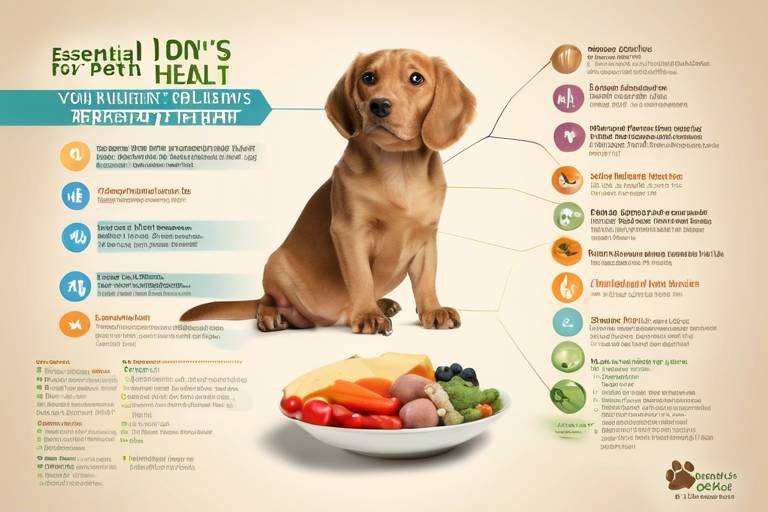Tips for Keeping Your Pet’s Skin Healthy
When it comes to our furry friends, their skin health is often an overlooked aspect of overall well-being. Just like humans, pets can suffer from a variety of skin issues that can lead to discomfort and even serious health problems. Keeping your pet's skin healthy is essential not only for their comfort but also for their happiness. In this article, we will explore some essential practices and tips that can help you maintain your pet's skin health, ensuring they remain comfortable and free from irritation or disease.
First, let’s dive into the unique characteristics of pet skin. Unlike human skin, which has a thicker epidermis, pet skin is generally thinner and more sensitive. This makes pets more susceptible to various skin issues, including allergies and infections. The skin acts as a barrier to protect against external elements, but when compromised, it can lead to a host of problems. Understanding this fundamental difference is crucial in recognizing symptoms early on and addressing them effectively.
Pets can face a plethora of skin issues that can be both bothersome and painful. Some of the most prevalent problems include:
- Allergies: These can be environmental or food-related, leading to itching and discomfort.
- Infections: Bacterial and fungal infections can thrive on compromised skin, causing further irritation.
- Parasites: Fleas, ticks, and mites can wreak havoc on your pet’s skin, leading to inflammation and hair loss.
Identifying these issues early can make all the difference in treatment and recovery. Keep an eye out for symptoms like excessive scratching, redness, or unusual odors, and consult your veterinarian for the best course of action.
Allergies can be a significant cause of skin problems in pets. Whether they arise from environmental factors like pollen or dust, or dietary components, the symptoms can manifest in various ways. Watch for signs such as:
- Itching and scratching
- Red or inflamed skin
- Hair loss
To alleviate their discomfort, consider making adjustments to their diet or environment. For instance, regular cleaning can minimize exposure to dust and pollen, while consulting your vet about dietary changes can help eliminate food allergens.
Pets can be sensitive to environmental allergens just like humans. Factors such as pollen, dust mites, and mold can trigger skin reactions. To help minimize exposure, consider the following practical steps:
- Keep your home clean and free from dust.
- Limit outdoor time during high pollen seasons.
- Use air purifiers to reduce indoor allergens.
By taking these measures, you can significantly improve your pet's quality of life.
Food allergies can be tricky to identify but are often linked to specific ingredients in pet food. Common culprits include grains, beef, and dairy. If you suspect your pet has a food allergy, try to:
- Keep a food diary to track what they eat and any symptoms.
- Consult your veterinarian about an elimination diet.
Eliminating allergens from your pet’s diet can lead to significant improvements in their skin health.
Bacterial and fungal infections are another common cause of skin issues in pets. These infections often occur when the skin barrier is compromised, allowing harmful microorganisms to invade. Additionally, parasites like fleas and ticks can lead to severe itching and skin irritation. Prevention is key, so regular treatments and check-ups are essential. If you notice any signs of infection or infestation, seek veterinary help promptly.
Grooming is not just about aesthetics; it's a vital part of maintaining your pet's skin health. Regular grooming can help prevent matting, reduce shedding, and promote overall skin health. Establishing a grooming routine that includes bathing, brushing, and de-shedding will keep your pet looking and feeling their best.
Bathing your pet regularly is important, but it’s crucial to use the right products. Look for shampoos specifically formulated for pets that won’t strip away essential oils. Over-bathing can lead to dryness, so a good rule of thumb is to bathe your pet every 4-6 weeks unless otherwise advised by your vet.
Regular brushing helps remove loose fur, dirt, and dander, promoting a healthier skin environment. Plus, it’s a great way to bond with your pet! Depending on their coat type, you may need to brush them more frequently. A well-groomed pet is not only healthier but also happier.
A balanced diet is crucial for maintaining skin health. Foods rich in essential fatty acids, particularly omega-3 and omega-6, can significantly improve your pet's skin condition. These nutrients help keep the skin supple and the coat shiny.
Incorporating omega-3 and omega-6 fatty acids into your pet's diet can promote healthy skin. These can be found in fish oils and certain plant oils. Consult your vet for recommendations on the best supplements or dietary adjustments to make.
Hydration is another critical aspect of skin health. Ensure your pet has access to fresh water at all times. Dehydration can lead to dry, flaky skin, which can exacerbate other skin issues. If your pet isn’t drinking enough, consider adding wet food to their diet or using a pet water fountain to encourage them to drink more.
Regular vet visits are essential for early detection of skin issues. During these appointments, veterinarians can perform skin assessments to check for any abnormalities. Early detection can prevent more serious issues from developing, so don’t skip those check-ups!
During a routine check-up, your vet will assess your pet’s skin for any signs of irritation, infections, or parasites. They will look for changes in color, texture, and overall health. Keeping a close eye on your pet's skin can help catch problems before they escalate.
Vaccinations and preventative treatments play a significant role in protecting your pet from skin-related diseases and infections. Ensuring your pet is up-to-date on vaccinations can help keep them healthy and happy.
Q: How often should I bathe my pet?
A: It depends on your pet's breed and lifestyle, but generally, every 4-6 weeks is recommended.
Q: What are the signs of skin allergies in pets?
A: Look for excessive scratching, redness, hair loss, and hot spots.
Q: Can diet affect my pet's skin health?
A: Absolutely! A balanced diet rich in essential fatty acids can improve skin condition.
Q: When should I take my pet to the vet for skin issues?
A: If you notice persistent itching, redness, or any unusual changes in your pet's skin, it's best to consult your veterinarian.

Understanding Pet Skin Health
Just like humans, our furry friends have their own unique skin characteristics that play a crucial role in their overall health. It’s fascinating to note that pet skin is actually quite different from human skin in terms of structure and function. For instance, pets have a thicker epidermis and a more complex hair follicle structure, which means they can be more susceptible to certain skin conditions. Understanding these differences is essential for any pet owner who wants to keep their beloved companion comfortable and healthy.
One of the most common issues that pet owners face is skin irritation, which can arise from a variety of factors, including allergies, infections, and environmental conditions. It’s vital to recognize the signs of skin problems early on, as untreated skin issues can lead to more serious health complications. For example, persistent scratching or biting at the skin can lead to open wounds, which can become infected and require veterinary intervention.
When it comes to pet skin health, there are several key aspects to consider:
- Skin Structure: Pet skin is designed to protect against environmental hazards, much like a shield. However, this protective barrier can be compromised, leading to various skin issues.
- Common Conditions: Pets can suffer from a range of skin problems, from allergies to infections, so it’s essential to stay vigilant.
- Prevention and Care: Regular grooming, proper nutrition, and routine veterinary check-ups are all critical components in maintaining your pet’s skin health.
To better understand how to care for your pet's skin, let’s delve deeper into the common skin issues they face and how you can help prevent them. Remember, just as you would visit a dermatologist for your skin concerns, your pet deserves the same level of care from a veterinarian. By being proactive and educating yourself about pet skin health, you ensure that your furry friend can enjoy a life that’s not only happy but also free from discomfort and irritation.
Q: How can I tell if my pet has a skin issue?
A: Look for signs such as excessive scratching, redness, swelling, or hair loss. If you notice any of these symptoms, it’s best to consult your veterinarian.
Q: What are some natural remedies for pet skin problems?
A: While some natural remedies can help soothe minor irritations, it’s important to consult your vet before trying any home treatments to ensure they are safe for your pet.
Q: How often should I groom my pet to maintain healthy skin?
A: Grooming frequency can vary based on the breed and coat type, but regular brushing and bathing (every 4-6 weeks) can help keep your pet’s skin healthy.
Q: Can diet affect my pet's skin health?
A: Absolutely! A balanced diet rich in essential fatty acids can significantly improve your pet's skin condition and overall well-being.

Common Skin Issues in Pets
When it comes to our furry friends, their skin health is often an overlooked aspect of their overall well-being. Just like humans, pets can suffer from a variety of skin issues that can lead to discomfort, irritation, and even more serious health problems if left untreated. Understanding these common skin issues is crucial for any pet owner who wants to ensure their beloved companion remains happy and healthy. From allergies to infections, let's dive into the most prevalent skin problems that pets face.
One of the most common issues is allergies. Pets can be allergic to various substances, whether they are environmental factors like pollen or dust, or even certain ingredients in their food. Allergies can cause symptoms such as itching, redness, and inflammation, which can make your pet quite uncomfortable. It's essential to keep an eye out for signs of allergies, as they can lead to secondary infections if your pet scratches excessively or licks their skin. If you notice your pet exhibiting unusual scratching or biting at their skin, it may be time to investigate potential allergens in their environment or diet.
Another significant concern is infections. Both bacterial and fungal infections can wreak havoc on your pet's skin. These infections often arise from broken skin or as a result of allergies. For instance, a pet that is constantly scratching due to allergies may create open wounds, making it easier for bacteria to invade. Symptoms of infections can include swelling, discharge, and a foul odor. If you suspect your pet has an infection, it's vital to consult your veterinarian promptly to prevent it from worsening.
Additionally, parasites like fleas and ticks are notorious for causing skin issues in pets. Not only do these pests cause itching and irritation, but they can also transmit diseases. Regularly checking your pet for signs of fleas or ticks is essential, especially if they spend a lot of time outdoors. If you find any parasites, there are various treatments available, from topical solutions to oral medications, which can help eliminate them and soothe your pet's skin.
To summarize, here are the three main skin issues to watch for:
- Allergies: Can be environmental or dietary, leading to itching and discomfort.
- Infections: Bacterial or fungal infections can develop from broken skin or allergies.
- Parasites: Fleas and ticks can cause irritation and transmit diseases.
By being aware of these common skin issues, you can take proactive steps to keep your pet's skin healthy. Regular grooming, a balanced diet, and routine veterinary check-ups can help detect and prevent these problems before they escalate. Remember, a happy pet is a healthy pet, and their skin is a window into their overall health!
Q: How can I tell if my pet has a skin issue?
A: Look for signs such as excessive scratching, redness, swelling, or unusual odors. If you notice any of these symptoms, it's best to consult your veterinarian.
Q: What are some common treatments for pet skin allergies?
A: Treatments can include antihistamines, dietary changes, or topical treatments. Your veterinarian can recommend the best course of action based on your pet's specific needs.
Q: How often should I groom my pet to maintain healthy skin?
A: The frequency of grooming depends on your pet's breed and coat type. Generally, regular grooming (at least once a week) can help prevent matting and skin issues.
Q: Can diet affect my pet's skin health?
A: Absolutely! A balanced diet rich in essential fatty acids can promote healthy skin and a shiny coat. If you suspect a food allergy, consult your vet for guidance.
Allergies and Sensitivities
When it comes to our furry friends, can be a real pain in the paws. Just like humans, pets can suffer from various allergies that can lead to uncomfortable skin conditions. Have you ever noticed your pet scratching incessantly, biting at their fur, or developing rashes? These could be signs of allergies that require your attention. Understanding the different types of allergies that can affect your pet is crucial for providing them with the comfort they deserve.
There are two primary categories of allergies that pet owners should be aware of: environmental allergies and food allergies. Environmental allergies are triggered by substances in your pet's surroundings, such as pollen, dust mites, mold, and even certain chemicals in household products. On the other hand, food allergies stem from specific ingredients in your pet's diet. Both types can lead to similar symptoms, making it essential to identify the root cause.
So, how can you tell if your pet is suffering from allergies? Look out for these common signs:
- Excessive itching and scratching
- Red, inflamed skin
- Hot spots or localized skin infections
- Hair loss or thinning fur
- Ear infections or discharge
If you notice any of these symptoms, it's time to take action. Start by observing your pet's behavior and environment. For instance, if your pet seems to worsen during certain seasons, it might be a sign of environmental allergies. In such cases, limiting exposure to allergens can make a significant difference. Regularly cleaning your home, using air purifiers, and keeping your pet's bedding fresh can help minimize their exposure to irritants.
When it comes to food allergies, the process can be a bit trickier. Identifying the offending ingredient often requires a bit of detective work, usually involving an elimination diet. This means removing all potential allergens from your pet's diet and slowly reintroducing them one at a time. Common allergens include:
- Beef
- Dairy
- Wheat
- Chicken
- Fish
Once you've pinpointed the allergen, you can adjust your pet's diet accordingly. Switching to a hypoallergenic pet food or one that contains novel proteins can be a game-changer for pets with food sensitivities.
In some cases, consulting a veterinarian is the best course of action. They can provide valuable insights and may recommend allergy testing to determine the specific triggers. Additionally, they can prescribe medications or suggest treatments, such as antihistamines or topical creams, to alleviate your pet's discomfort.
In conclusion, being proactive about your pet's skin health is essential. By understanding the signs of allergies and sensitivities, you can take steps to create a more comfortable environment for your furry companion. Remember, a happy pet is a healthy pet, and addressing these issues early can save you both a lot of stress down the line.
- What are the most common signs of allergies in pets? Look for excessive scratching, red skin, and hair loss.
- How can I prevent environmental allergies? Regular cleaning and using air purifiers can help reduce allergens in your home.
- What should I do if I suspect my pet has a food allergy? Consider an elimination diet to identify the allergen, and consult your vet for guidance.
- Can allergies be treated? Yes, treatments include dietary changes, medications, and lifestyle adjustments.
Environmental Allergies
Environmental allergies are a common issue that can significantly impact your pet's skin health. Just like us, pets can develop sensitivities to various allergens present in their surroundings. These allergens can include pollen, dust mites, mold spores, and even certain chemical irritants found in household cleaners or air fresheners. When your furry friend comes into contact with these triggers, it can lead to a range of uncomfortable symptoms, including itching, redness, and inflammation of the skin.
One of the most telling signs that your pet may be suffering from environmental allergies is persistent scratching or biting at their skin. You might notice them frequently rubbing their face against furniture or rolling on the ground in an attempt to relieve their discomfort. Additionally, watch for other symptoms such as watery eyes, sneezing, or a runny nose, which can accompany skin reactions.
So, how can you help your pet combat these pesky environmental allergens? Here are some practical steps you can take:
- Regular Cleaning: Keep your home clean by vacuuming frequently and using air purifiers to reduce dust and allergens.
- Bathing Routine: Bathe your pet regularly using a gentle hypoallergenic shampoo to remove allergens from their coat.
- Avoidance: When possible, limit your pet's exposure to known allergens, such as staying indoors during high pollen counts.
In some cases, your veterinarian may recommend allergy testing to identify specific triggers. This can be incredibly helpful in creating a tailored management plan for your pet. Treatments may include antihistamines, corticosteroids, or even allergy shots, depending on the severity of the allergies. Remember, it's essential to consult with your vet before starting any treatment to ensure it's appropriate for your pet's specific needs.
By being proactive and attentive to your pet's skin health, you can help them enjoy a more comfortable life, free from the discomfort of environmental allergies. Keeping a close eye on their behavior and symptoms can lead to early detection and effective management of these common issues.
Q: What are some common signs of environmental allergies in pets?
A: Common signs include itching, redness, inflammation, and excessive scratching or licking. You may also notice respiratory symptoms like sneezing or watery eyes.
Q: Can I use human allergy medications on my pet?
A: No, many human medications can be harmful to pets. Always consult your veterinarian before giving any medication to your pet.
Q: How often should I bathe my pet to help with allergies?
A: It depends on your pet's specific needs, but a general rule of thumb is to bathe them every 4 to 6 weeks using a hypoallergenic shampoo. Consult your vet for personalized advice.
Q: Are there any special diets that can help with skin allergies?
A: Yes, some pets benefit from a diet rich in omega fatty acids, which can help improve skin health. Your vet can recommend suitable dietary options.
Food Allergies
Understanding in pets can be a bit like solving a mystery. Just like humans, pets can have reactions to certain ingredients in their diet, which can lead to uncomfortable skin issues. If your furry friend is scratching more than usual, it might not just be a case of fleas; it could be their food. It's essential to pay close attention to the signs your pet exhibits, as these can guide you toward identifying the culprit.
Common symptoms of food allergies in pets include:
- Persistent itching and scratching
- Red, inflamed skin
- Hot spots or rashes
- Excessive licking of paws or other body parts
- Digestive issues such as vomiting or diarrhea
So, what can you do if you suspect your pet has a food allergy? First, it’s crucial to consult with your veterinarian. They can help you determine the best course of action, which typically involves an elimination diet. This process requires you to remove potential allergens from your pet's diet and gradually reintroduce them one at a time to pinpoint the exact cause of the allergy.
Some common allergens found in pet foods include:
| Common Allergens | Symptoms |
|---|---|
| Beef | Itching, digestive upset |
| Dairy | Skin irritation, vomiting |
| Wheat | Itchy skin, ear infections |
| Chicken | Redness, excessive licking |
| Eggs | Skin rashes, gastrointestinal issues |
Once you’ve identified the allergen, you can start looking for hypoallergenic pet food options. These are specially formulated to reduce the likelihood of allergic reactions and often contain novel protein sources, such as duck or venison, which your pet might not have been exposed to before.
Additionally, consider incorporating omega fatty acids into your pet's diet. These can help to soothe and nourish the skin, making it more resilient against irritants. Remember, changing your pet's diet is not just about eliminating allergens; it's about ensuring they receive a balanced and nutritious diet that supports their overall health.
In conclusion, if you notice any signs of food allergies in your pet, don’t hesitate to take action. With the right approach, you can help your pet feel comfortable and happy in their own skin. Always consult with a veterinarian for tailored advice and to ensure that any dietary changes are safe and beneficial for your furry friend.
Q: How long does it take to identify a food allergy in my pet?
A: The elimination diet process can take several weeks to a few months, depending on how quickly you can identify the allergen. Patience is key!
Q: Can I treat my pet's food allergies at home?
A: While you can make dietary changes at home, it's essential to work closely with your veterinarian to ensure your pet's health and safety during the process.
Q: Are there specific brands of pet food that are better for pets with food allergies?
A: Many brands offer hypoallergenic options. Your vet can recommend specific brands based on your pet’s needs.
Infections and Parasites
When it comes to your furry friends, one of the most concerning issues for pet owners is the presence of . These unwelcome guests can cause serious skin problems, leading to discomfort and distress for your pet. Just like us, pets can suffer from a variety of skin infections, which can be caused by bacteria, fungi, or parasites like fleas and ticks. Understanding how these issues manifest is crucial for keeping your pet healthy and happy.
Infections in pets can arise from various sources, including injuries, allergies, or even poor hygiene. For instance, a simple scratch might become infected if bacteria enter the wound. Common signs of a skin infection include:
- Redness and inflammation
- Swelling and heat in the affected area
- Pus or discharge
- Persistent itching or licking
If you notice any of these symptoms, it's essential to consult your veterinarian promptly. They can provide the necessary diagnosis and treatment, which may include antibiotics or antifungal medications, depending on the type of infection.
Parasites, on the other hand, can wreak havoc on your pet's skin health. Fleas, ticks, and mites are the most common culprits, and they can lead to a range of issues, from mild irritation to severe allergic reactions. Fleas, for example, can cause intense itching, leading to hair loss and skin infections due to excessive scratching. Ticks can transmit diseases that affect not just the skin but the overall health of your pet.
Here’s a quick comparison of some common parasites and their effects:
| Parasite | Common Symptoms | Potential Treatments |
|---|---|---|
| Fleas | Itching, hair loss, flea dirt | Topical treatments, oral medications |
| Ticks | Redness, swelling, lethargy | Tick removal, preventive treatments |
| Mites | Itching, scabs, hair loss | Topical treatments, medicated shampoos |
To keep your pet safe from these pesky intruders, regular grooming and preventive measures are key. Make it a habit to check your pet's skin frequently for any signs of infestation or infection. Use flea and tick preventatives as recommended by your veterinarian, and ensure your pet's living environment is clean and free from pests.
In conclusion, being vigilant about your pet's skin health is essential. By understanding the signs of infections and parasites, you can take proactive steps to ensure your furry friend remains comfortable and disease-free. Regular vet check-ups and timely interventions can make a world of difference in your pet's quality of life.
- What are the most common signs of skin infections in pets? Look for redness, swelling, discharge, and excessive scratching.
- How can I prevent parasites on my pet? Regular grooming, using preventive medications, and keeping your home clean can help.
- When should I take my pet to the vet for skin issues? If you notice persistent symptoms like itching or redness, it’s best to consult your vet.

Proper Grooming Techniques
Grooming your pet is not just about keeping them looking fabulous; it's a vital part of maintaining their overall skin health. Think of grooming as a spa day for your furry friend, where every brush stroke and bath helps to keep their skin in tip-top shape. Regular grooming can prevent matting, reduce shedding, and even promote better circulation, which is essential for healthy skin. But what exactly should you be doing? Let’s dive into some effective grooming techniques that will leave your pet feeling comfortable and looking great!
First off, bathing is a crucial component of your pet's grooming routine. Regular baths help to remove dirt, dander, and excess oils that can accumulate on their skin. However, it’s important to choose the right products. Using a gentle, pet-specific shampoo is key; human shampoos can strip away the natural oils that protect your pet's skin. Aim to bathe your pet every 4-6 weeks, but keep an eye on their skin—if it looks oily or dirty, it might be time for a wash sooner!
When it comes to brushing, this should be a regular ritual, regardless of your pet's coat type. Brushing not only removes loose fur and dirt but also helps to distribute natural oils across their skin, which keeps it moisturized and healthy. For long-haired breeds, daily brushing can prevent tangles and mats, while short-haired pets can usually get away with a weekly brushing session. Consider investing in a few different types of brushes to find what works best for your pet's specific coat type.
Another aspect of grooming that often gets overlooked is de-shedding. If you have a breed that sheds heavily, using a de-shedding tool can drastically reduce the amount of hair that ends up on your floor and furniture. These tools help to remove the undercoat without damaging the top coat, leading to a healthier skin environment. Regular de-shedding sessions can also keep your pet cooler in warmer months, as it allows for better air circulation through their fur.
Now, let’s talk about nail trimming. While it might not seem directly related to skin health, overgrown nails can lead to discomfort and even injury, which can result in skin problems. Make it a habit to check your pet's nails regularly and trim them as needed. If you're unsure how to do this safely, don’t hesitate to ask your veterinarian or a professional groomer for guidance.
Finally, don't forget about your pet's ears and teeth. Regular ear cleaning can prevent infections that can affect the skin around the ears, while dental care contributes to overall health, reducing the risk of skin issues related to systemic infections. Establishing a comprehensive grooming routine can significantly impact your pet's skin health and overall well-being.
- How often should I groom my pet? It depends on the breed and coat type. Generally, long-haired pets require more frequent grooming than short-haired ones.
- Can I use human shampoo on my pet? No, human shampoos can strip away natural oils and cause skin irritation. Always use pet-specific products.
- What if my pet hates being groomed? Start slowly and make it a positive experience with treats and praise. Gradually introduce grooming tools to help them get used to the process.
- How can I tell if my pet's skin is healthy? Look for a shiny coat, minimal shedding, and no signs of redness, irritation, or excessive scratching.
Bathing and Shampooing
Bathing your pet is more than just a routine chore; it’s a vital part of maintaining their skin health and overall well-being. Just like us, our furry friends can accumulate dirt, oil, and allergens on their skin, which can lead to irritation and discomfort. But how often should you bathe your pet? Well, it largely depends on their breed, coat type, and lifestyle. For instance, dogs with oily coats may need more frequent baths compared to those with dry coats. Generally, a good rule of thumb is to bathe your dog every 4 to 6 weeks, while cats usually require less frequent bathing due to their self-grooming habits.
When it comes to choosing the right shampoo, you want to ensure that it’s specifically formulated for pets. Human shampoos can be too harsh and strip away the natural oils that protect their skin. Look for products that contain natural ingredients and are free from harsh chemicals. A good pet shampoo should also be pH balanced to cater to your pet's unique skin needs. Here’s a quick comparison of some common shampoo types:
| Shampoo Type | Best For | Key Ingredients |
|---|---|---|
| Moisturizing Shampoo | Dry skin | Aloe Vera, Oatmeal |
| Hypoallergenic Shampoo | Allergies | Natural Oils, Chamomile |
| Flea and Tick Shampoo | Parasite control | Pyrethrin, Natural Flea Repellents |
Before you start the bathing process, it’s essential to prepare your pet. Make sure to brush their coat thoroughly to remove any loose hair and mats. This will not only make the bathing process easier but will also help in distributing natural oils throughout their coat. Once you’re ready to bathe them, use lukewarm water and ensure that the bathing area is safe and comfortable. If your pet is anxious about baths, consider using treats or toys to make the experience more enjoyable.
During the bath, apply the shampoo evenly, starting from the neck and working your way down to avoid getting it in their eyes and ears. Gently massage the shampoo into their coat for a few minutes to ensure it penetrates the skin and lifts away dirt and allergens. Rinse thoroughly to avoid any residue, which can lead to skin irritation. After rinsing, it’s crucial to dry your pet properly. You can use a towel or a pet-safe blow dryer on a low setting, ensuring they are completely dry to prevent any fungal infections.
Remember, bathing is just one part of the grooming process. Regular grooming sessions, which include brushing and de-shedding, can significantly enhance your pet’s skin health. By keeping their coat clean and free of debris, you’re not only improving their appearance but also fostering a healthy environment for their skin. So, the next time you think about skipping a bath, remember: a clean pet is a happy pet!
- How often should I bathe my pet? It depends on their breed and coat type, but generally every 4 to 6 weeks is a good guideline for dogs.
- Can I use human shampoo on my pet? No, human shampoos can be too harsh and may disrupt your pet's skin pH balance.
- What should I do if my pet hates baths? Use treats, toys, and positive reinforcement to make the experience more enjoyable for them.
- Is it necessary to dry my pet after a bath? Yes, drying is important to prevent skin problems like fungal infections.
Brushing and De-shedding
Brushing and de-shedding your pet is not just a chore; it's a vital part of maintaining their skin health and overall well-being. Regular grooming sessions can be a delightful bonding experience for you and your furry friend, transforming a mundane task into quality time. Think of it like a spa day for your pet—who doesn’t love a good pampering session? Not only does brushing keep their coat looking fabulous, but it also helps to remove loose fur, dirt, and dander that can irritate their skin.
When you brush your pet, you’re also stimulating the skin and promoting healthy blood circulation, which is essential for maintaining a vibrant coat. It’s like giving your pet a mini-massage! However, the benefits of brushing go beyond aesthetics. By regularly de-shedding your pet, you can significantly reduce the amount of fur that ends up on your furniture, clothes, and floors. A win-win situation, wouldn’t you agree?
But how often should you brush your pet? Well, that depends on their coat type. For instance:
| Coat Type | Brushing Frequency |
|---|---|
| Short-haired | Once a week |
| Medium-haired | 2-3 times a week |
| Long-haired | Daily |
In addition to the frequency, choosing the right tools is crucial for effective grooming. A slicker brush is perfect for removing tangles and mats, while a bristle brush works wonders on short-haired breeds. And don’t forget about grooming gloves! They can be a fun way to bond with your pet while effectively de-shedding them.
After a good brushing session, it’s essential to check your pet’s skin for any signs of irritation or parasites, such as fleas and ticks. This proactive approach can help catch any potential issues early on, ensuring your pet remains comfortable and healthy. So, next time you pick up that brush, remember that you’re not just keeping your home fur-free; you’re also contributing to your pet’s happiness and skin health.
- How often should I brush my pet? It depends on their coat type—short-haired pets can be brushed once a week, while long-haired pets may need daily brushing.
- What tools should I use for brushing? A slicker brush is great for long-haired pets, while a bristle brush works well for short-haired breeds. Grooming gloves are also a fun option!
- Can brushing help with shedding? Yes, regular brushing can significantly reduce shedding by removing loose fur and dander.
- What should I look for while brushing? Keep an eye out for any skin irritations, lumps, or parasites like fleas and ticks during your grooming sessions.

Nutrition for Healthy Skin
When it comes to keeping your pet's skin healthy, nutrition plays a crucial role. Just like us, our furry friends need a well-balanced diet to thrive, and their skin is no exception. A diet rich in essential nutrients not only promotes a shiny coat but also helps to prevent various skin issues. Think of your pet's skin as a canvas; the better the quality of the paint, the more vibrant and healthy the picture will be. So, what should you be feeding your pet to ensure their skin stays in tip-top shape?
First and foremost, essential fatty acids are vital for maintaining healthy skin. Omega-3 and omega-6 fatty acids, in particular, play a significant role in skin health. These fatty acids help to keep the skin hydrated, reduce inflammation, and promote a shiny coat. You can find these nutrients in fish oil, flaxseeds, and certain types of pet food. If you're considering adding supplements, always consult your veterinarian to determine the right dosage and type for your pet.
Another important factor is hydration. Just like humans, pets need to drink enough water to stay hydrated. Dehydration can lead to dry, flaky skin and can exacerbate existing skin conditions. To ensure your pet is drinking enough, make sure they have access to fresh water at all times. You might even consider investing in a pet water fountain, as many pets prefer running water over stagnant water. Keeping your pet well-hydrated is like giving them a refreshing drink on a hot day—it makes all the difference!
Moreover, the quality of your pet's food matters immensely. Look for high-quality pet food that lists meat as the first ingredient and is free from artificial additives and fillers. Foods rich in antioxidants, vitamins, and minerals will support not only skin health but overall well-being. Ingredients like sweet potatoes, carrots, and blueberries can be excellent additions to your pet's diet. These nutrients work together to strengthen the immune system and promote healthy skin. Just imagine feeding your pet a colorful plate of food—each color representing a different nutrient that contributes to their health!
Additionally, it’s essential to be aware of potential food allergies that might affect your pet's skin. Some pets can develop sensitivities to specific ingredients, leading to skin irritations or infections. If you notice your pet scratching excessively or experiencing hair loss, it may be time to reevaluate their diet. You can start by eliminating common allergens such as grains, dairy, or certain proteins, and then gradually reintroducing them to identify the culprit. This process can be a bit like a detective story, where you piece together clues to solve the mystery of your pet's discomfort.
In summary, providing your pet with a balanced diet rich in essential fatty acids, ensuring they stay hydrated, and being mindful of food allergies can significantly impact their skin health. By paying attention to their nutritional needs, you're not just feeding them; you're investing in their comfort and happiness. Remember, a happy pet is a healthy pet!
- What foods are best for my pet's skin health? Look for high-quality pet foods rich in omega-3 and omega-6 fatty acids, antioxidants, and vitamins. Ingredients like fish, sweet potatoes, and blueberries are excellent choices.
- How can I tell if my pet has a food allergy? Signs of food allergies include excessive scratching, hair loss, and skin infections. If you suspect an allergy, consult your veterinarian for guidance on elimination diets.
- How much water should my pet drink daily? While it varies by size and activity level, a general rule of thumb is that pets should drink about an ounce of water per pound of body weight each day.
Essential Fatty Acids
When it comes to keeping your pet's skin healthy, play a pivotal role. These are not just any fats; they are crucial for maintaining a shiny coat and preventing dry, flaky skin. Imagine essential fatty acids as the superheroes of your pet's diet, fighting off dryness and irritation while promoting overall skin health. The two most important types of essential fatty acids for pets are omega-3 and omega-6. These fatty acids cannot be produced by your pet's body, which means they must be obtained through their diet.
Omega-3 fatty acids are known for their anti-inflammatory properties, which can help alleviate skin conditions such as allergies and dermatitis. On the other hand, omega-6 fatty acids are vital for maintaining the skin's barrier function, which helps retain moisture and keep irritants at bay. Without a proper balance of these fatty acids, your pet may experience a range of skin issues, from excessive shedding to more severe conditions like hot spots.
So, how can you ensure your furry friend is getting enough of these essential nutrients? One effective way is by incorporating high-quality pet foods that list fish oil or flaxseed oil as ingredients. These oils are rich in omega-3 fatty acids and can significantly improve your pet's skin health. You can also consider adding supplements specifically designed for pets, which can provide concentrated doses of these fatty acids.
| Type of Fatty Acid | Source | Benefits |
|---|---|---|
| Omega-3 | Fish oil, flaxseed oil, chia seeds | Reduces inflammation, promotes shiny coat |
| Omega-6 | Chicken fat, corn oil, sunflower oil | Maintains skin barrier, retains moisture |
It’s essential to remember that balance is key. Too much omega-6 in relation to omega-3 can lead to inflammation, so always consult your veterinarian before making any significant changes to your pet's diet. They can help you determine the right balance for your pet's specific needs, ensuring that they remain comfortable and healthy.
In summary, providing your pet with the right amount of essential fatty acids can lead to a noticeable improvement in their skin condition. By choosing the right foods and possibly adding supplements, you can help your furry friend maintain a healthy, vibrant coat and avoid the discomfort that comes with skin issues. After all, a happy pet is a healthy pet!
- What are essential fatty acids? Essential fatty acids are fats that pets cannot produce on their own and must obtain through their diet.
- How do omega-3 and omega-6 fatty acids differ? Omega-3s are anti-inflammatory, while omega-6s help maintain the skin's moisture barrier.
- Can I give my pet supplements for fatty acids? Yes, but consult your veterinarian to find the right dosage and type for your pet.
- What foods are good sources of these fatty acids? Fish oil, flaxseed oil, and certain meats are excellent sources.
Hydration and Skin Health
When it comes to keeping your pet's skin healthy, one of the most critical yet often overlooked aspects is hydration. Just like humans, pets require an adequate amount of water to maintain optimal health, and this is especially true for their skin. Imagine your pet's skin as a sponge; when it's well-hydrated, it remains supple and elastic, but when it's dry, it can become cracked and uncomfortable. So, how can you ensure your furry friend stays hydrated?
First, it's essential to understand that different pets have varying hydration needs based on their size, age, and activity level. For instance, a playful puppy will need more water than a senior cat lounging around the house. On average, dogs need about 1 ounce of water per pound of body weight daily, while cats generally require about 2.5 to 4.5 ounces of water per 5 pounds of body weight. Keeping an eye on your pet's drinking habits can help you gauge if they're getting enough fluids.
One effective way to encourage your pet to drink more water is by providing fresh and clean water at all times. Pets are more likely to drink if their water bowl is filled with fresh water regularly. Additionally, consider using a pet water fountain—the flowing water can be more enticing and may encourage your pet to drink more. If your pet seems disinterested in drinking, you can also try adding a splash of low-sodium broth to their water or offering ice cubes as a treat.
Moreover, hydration doesn't just come from drinking water; it can also be obtained through food sources. Many wet pet foods contain a higher moisture content compared to dry kibble, making them an excellent choice for hydration. If your pet is on a dry food diet, you might want to mix in some wet food or even add water to their kibble to enhance moisture intake. Remember, a well-hydrated pet is less likely to suffer from skin issues like dryness or irritation.
To sum it up, ensuring your pet stays hydrated is a vital step in maintaining their skin health. Consider the following tips:
- Always provide fresh water.
- Use a pet water fountain to encourage drinking.
- Incorporate wet food into their diet.
- Monitor their water intake based on their size and activity level.
By keeping these hydration tips in mind, you can help your pet enjoy healthier skin and overall well-being. Remember, a happy pet is a hydrated pet!
Q: How do I know if my pet is dehydrated?
A: Signs of dehydration in pets can include dry gums, lethargy, loss of appetite, and reduced skin elasticity. If you pinch your pet's skin and it doesn't return to its original position quickly, this may indicate dehydration.
Q: Can I give my pet flavored water?
A: Yes, providing low-sodium broth or flavored water can entice your pet to drink more, but ensure it's safe for pets and doesn't contain any harmful ingredients like onions or garlic.
Q: How much water should my pet drink daily?
A: Generally, dogs need about 1 ounce of water per pound of body weight, while cats require about 2.5 to 4.5 ounces per 5 pounds of body weight. Adjust these amounts based on your pet's activity level and size.

Regular Veterinary Check-ups
Regular veterinary check-ups are vital for maintaining your pet's overall health, especially when it comes to skin care. Just like we visit our doctors for routine check-ups, our furry friends need the same attention to catch potential issues before they escalate. These visits serve as a preventive measure, allowing veterinarians to identify early signs of skin problems that you might not notice at home. Imagine your pet’s skin health as a garden; without regular care and attention, weeds can quickly take over, leading to bigger problems down the line.
During these check-ups, veterinarians will conduct thorough skin assessments, looking for any signs of irritation, infections, or unusual growths. They will examine your pet's coat, skin texture, and overall condition, ensuring that everything is as it should be. Regular assessments can help catch issues like allergies, infections, or even skin cancer early on, which can make a significant difference in treatment outcomes. You might be wondering what exactly your vet will look for during these assessments. Here are some key points:
- Skin Texture: Is it smooth, or are there lumps, bumps, or scabs?
- Color Changes: Are there any unusual discolorations or redness?
- Parasites: Are there signs of fleas, ticks, or mites?
- Odor: Any unusual smells that could indicate an infection?
Additionally, these visits provide an opportunity for you to discuss any concerns you might have noticed at home. Have you seen your pet scratching more than usual? Or perhaps you've noticed some hair loss? This is your chance to bring those observations to your vet's attention. The more information you provide, the better equipped your veterinarian will be to diagnose any potential skin issues.
Moreover, regular check-ups often include vaccinations and preventative treatments that can protect your pet from various skin-related diseases. Vaccinations are not just for preventing common illnesses; they can also shield your pet from conditions that may lead to skin complications. Think of it as a shield, keeping your pet safe from potential invaders that could cause harm.
To summarize, regular veterinary check-ups are essential for:
| Benefit | Description |
|---|---|
| Early Detection | Identifying skin issues before they become severe. |
| Preventative Care | Administering vaccinations and treatments to prevent diseases. |
| Expert Advice | Getting professional insights on your pet's skin health. |
In conclusion, think of your pet's health as a priority, and regular veterinary check-ups as the maintenance routine it deserves. Just like a car needs regular oil changes to run smoothly, your pet needs routine check-ups to stay healthy and happy. So, don’t skip those vet appointments; they’re crucial for keeping your furry friend’s skin—and overall health—in tip-top shape!
1. How often should I take my pet for a veterinary check-up?
Most pets should visit the vet at least once a year, but senior pets or those with existing health issues may require more frequent visits.
2. What should I expect during a veterinary check-up?
Your vet will perform a physical examination, ask about your pet's behavior and health history, and may recommend vaccinations or tests based on their findings.
3. How can I prepare my pet for a vet visit?
Make sure your pet is comfortable in their carrier, bring any relevant medical records, and jot down any questions or concerns you may have.
4. Can I prevent skin problems with regular vet visits?
Absolutely! Regular check-ups allow for early detection and treatment of potential skin issues, significantly reducing the risk of severe problems.
Skin Assessments
When it comes to keeping your furry friend healthy, are crucial. These evaluations, conducted by your veterinarian during regular check-ups, help in identifying any potential skin issues before they escalate. You might wonder, what exactly do veterinarians look for during these assessments? Well, they examine several factors that can indicate the overall health of your pet's skin.
One of the first things a vet will check is the condition of the skin and coat. They will look for signs of dryness, flakiness, or excessive oiliness. These conditions can be indicative of underlying health issues or nutritional deficiencies. For instance, a dull coat may suggest a lack of essential fatty acids in your pet's diet, while excessive oiliness might point towards skin infections or allergies.
Another key aspect of skin assessments is the presence of parasites. Your vet will check for fleas, ticks, and mites, which can cause significant discomfort and lead to more severe skin problems if left untreated. Regular checks can help in early detection, allowing for timely treatment and preventing further complications.
Additionally, your veterinarian will assess for any signs of inflammation or infection. This includes looking for redness, swelling, or any unusual lumps or bumps. If your vet notices any of these symptoms, they may recommend further diagnostic tests such as skin scrapes or biopsies to determine the root cause of the issue.
To give you a clearer picture, here’s a simple table summarizing what veterinarians typically assess during a skin examination:
| Assessment Area | What to Look For |
|---|---|
| Skin Condition | Dryness, flakiness, oiliness |
| Parasite Presence | Fleas, ticks, mites |
| Signs of Infection | Redness, swelling, lumps |
It's essential to remember that early detection is the key to preventing more serious skin issues from developing. If your vet identifies any problems during the assessment, they can recommend appropriate treatments or lifestyle changes to keep your pet’s skin healthy and comfortable. Regular skin assessments not only help in maintaining your pet's skin health but also strengthen the bond between you and your furry companion, as you work together to ensure their well-being.
- How often should my pet have a skin assessment? - It's recommended to have a veterinary check-up at least once a year, but pets with known skin issues may need more frequent evaluations.
- What are the signs that my pet may have a skin problem? - Look for excessive scratching, redness, swelling, or changes in their coat's appearance.
- Can I perform my own skin assessments at home? - Yes, regularly checking your pet’s skin and coat can help you notice any changes that may require veterinary attention.
Vaccinations and Preventatives
When it comes to keeping your pet's skin healthy, vaccinations and preventative treatments are your first line of defense. Just like humans, pets can be susceptible to various diseases and infections that can wreak havoc on their skin. Regular vaccinations not only protect against serious illnesses but also help in preventing skin-related issues that can arise from these diseases. For instance, certain viral infections can lead to skin lesions, while bacterial infections can cause itching and discomfort. By ensuring your pet is up-to-date with their vaccinations, you significantly reduce the risk of these problems.
But vaccinations are just one part of the puzzle. Preventative treatments, such as flea and tick medications, play a crucial role in maintaining your pet's skin health. Fleas and ticks are notorious for causing skin irritations, allergic reactions, and even severe infections. By incorporating a regular schedule of preventative treatments, you can keep these pesky parasites at bay. It's essential to choose the right products for your pet's size, age, and health condition. Always consult with your veterinarian to find the most effective treatments tailored to your furry friend.
Moreover, understanding the timing and type of vaccinations is vital. Here’s a quick overview of common vaccinations and their benefits related to skin health:
| Vaccination | Prevention | Skin Health Impact |
|---|---|---|
| Rabies | Prevents rabies virus infection | Reduces risk of skin lesions from bites |
| Distemper | Prevents distemper virus infection | Protects against skin infections |
| Parvovirus | Prevents parvovirus infection | Reduces complications that can affect skin |
| Leptospirosis | Prevents leptospirosis | Protects against skin-related symptoms |
Additionally, regular veterinary check-ups are essential for assessing your pet's skin health. During these visits, your vet will evaluate your pet's skin for any signs of irritation or infection, and they can recommend the appropriate vaccinations and preventative measures based on your pet's specific needs. Remember, early detection is key in preventing more serious health issues down the road.
In summary, keeping your pet's skin healthy is a multifaceted approach that includes vaccinations and preventative treatments. By staying proactive, you can ensure that your furry companion remains comfortable, happy, and free from skin-related problems. So, don’t skip those vet visits, and always keep an eye on your pet’s skin health!
- How often should my pet be vaccinated? - Most pets require vaccinations annually, but consult your vet for a tailored schedule.
- What are the signs of skin issues in pets? - Look for excessive scratching, redness, swelling, or unusual odors.
- Can I use human shampoo on my pet? - No, human shampoos can disrupt your pet's skin pH balance. Use pet-specific products instead.
- Are there natural remedies for skin issues? - Some natural remedies exist, but always consult your vet before trying them.
Frequently Asked Questions
- What are the signs of skin issues in pets?
Common signs of skin problems in pets include excessive scratching, redness, swelling, hair loss, and unusual odors. If you notice your pet frequently licking or biting at their skin, it's a good idea to consult your veterinarian.
- How can I prevent allergies in my pet?
To prevent allergies, try to minimize your pet's exposure to common allergens like pollen and dust. Regular grooming, using air purifiers, and keeping your home clean can help. Additionally, consult your vet about dietary adjustments if you suspect food allergies.
- How often should I bathe my pet?
The frequency of bathing depends on your pet's breed, coat type, and lifestyle. Generally, most pets benefit from a bath every 4 to 6 weeks. However, over-bathing can strip essential oils, so it's important to find a balance.
- What type of shampoo should I use for my pet?
Always use shampoos specifically formulated for pets. Look for products that are gentle and free from harsh chemicals. If your pet has specific skin conditions, consult your vet for recommendations on medicated shampoos.
- Are there specific foods that can help with my pet's skin health?
Yes! Foods rich in omega-3 and omega-6 fatty acids, such as fish oil, can significantly improve skin health. Additionally, high-quality pet food that includes whole ingredients without fillers or artificial additives is essential for maintaining a healthy coat.
- How can I tell if my pet is dehydrated?
Signs of dehydration include dry gums, lethargy, and a loss of skin elasticity. You can check skin elasticity by gently pinching the skin at the back of the neck. If it doesn't spring back quickly, your pet may need more fluids.
- Why are regular vet check-ups important for skin health?
Regular vet check-ups allow for early detection of potential skin issues before they become serious. Your vet can perform skin assessments, recommend preventative treatments, and ensure your pet is up-to-date on vaccinations.
- What should I do if I find fleas or ticks on my pet?
If you find fleas or ticks, it's crucial to act quickly. Use vet-recommended flea and tick treatments, and consult your veterinarian for the best course of action. Regular preventative treatments can also help keep these pests at bay.



















